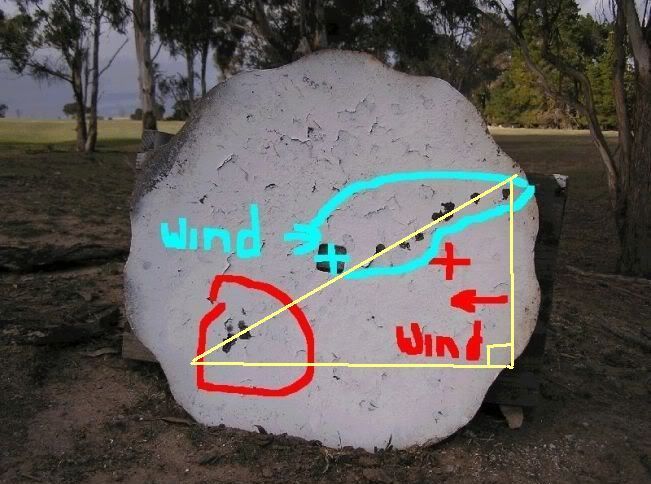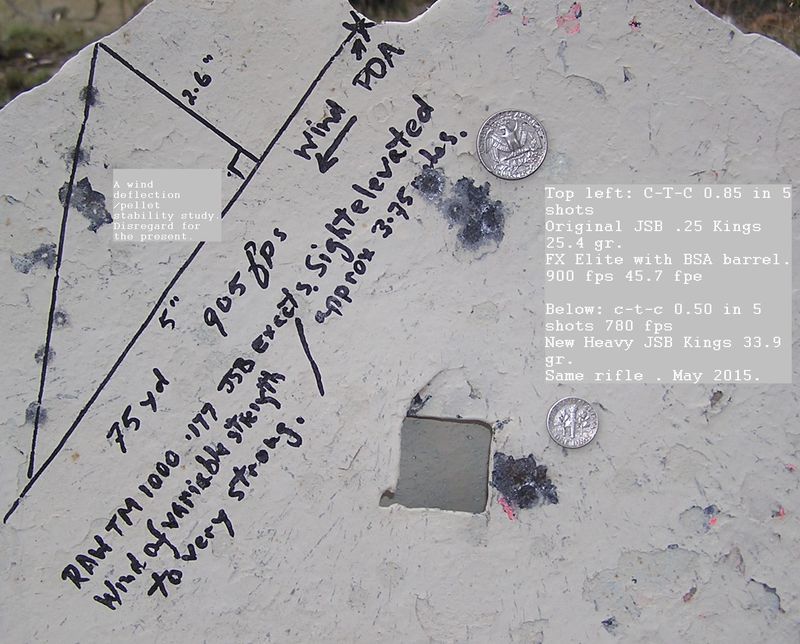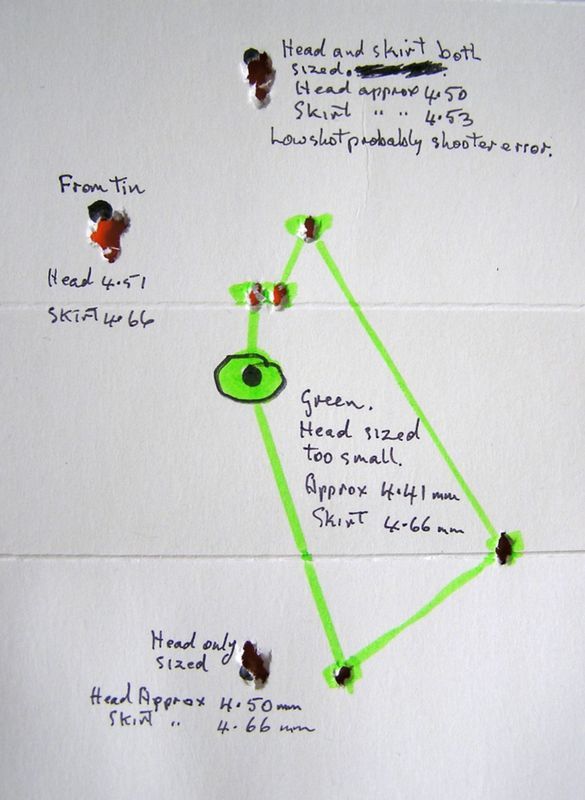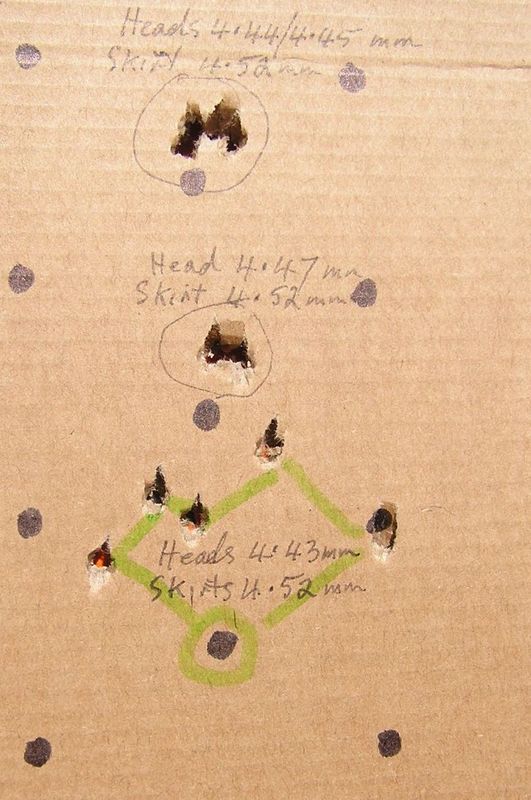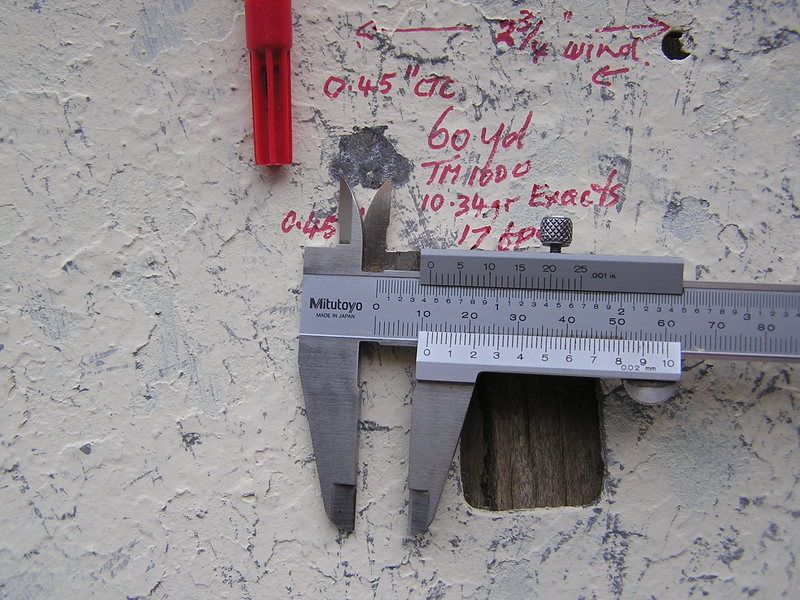AJshoots, and others who may have become confused by recent well meaning attempts of some of us to discuss ideas and concepts relating to twist rates and spin rates and stability factors:
Please don't get hung up on twist rates at this point in time as such relates to accurate/precision shooting at longer ranges. Our best conventional and slightly innovative barrels are up to the job.
Evidence can be found in this bit of history.
The current bench mark for 100 yard 5 shot groups is ctc one inch. In best conditions that standard can be averaged in a session of five to ten groups with best conventional barrels.
Since 2002/3 when Chris Thomas, also from OZ, and I shot the first reported such groups, on the world stage the interest and success has gathered momentum.
By 2008 I knew of some 25 shooters from 9 countries from Australia (first), New Zealand to Argentina, USA, RSA, Russia, Netherlands, Belgium and UK, who had shot sub inch at 100 yards (I think also Brazil); too many now to name like Bulgaria . They had used a number of different off the shelf rifles, some modified, and all would have had twist rates of roughly 1:18 to 1:16" and used JSB pellets and a few of H&N Baracudas.
I have personally shot in excess of one hundred such groups since 2003 using five different rifles with nine different barrels, in calibres .177, .22 and .25 including FX ST .22 and .25, LW .177 and .22, and BSA .22 and .25 and one Benchmark 3 g .22. With the exception of the ST barrels' effective spin rates, all had twist rates as indicated above. The Benchmark is a tight rimfire barrel. (Most best BR rimfire barrels are tight bores now and some can do very well with pellets).
Lampies Lamprecht in RSA could well by now have shot as many or more than I; and he added the .20 calibre to the lineup (was also first with the .177 cal). He and I and at least three others I know of, have shot sub half inch 5 shot 100 yards groups. I shot two in one session when 7 of 12 groups went under the inch and the average was under one inch. The same conventional AG twist rates prevailed. The number of 10 shot sub inch 100 yards groups too is climbing. Even Martin Rutterford of RAW rifles USA has shot a 10 shot group well under the inch with a .22 LW conventional barrel.
To my knowledge none of these has required the use of actual machine clamped rests; and Lampies' (and most of mine) have all been shot seated with a wrist rest over a blanket roll (Lampies) or sand bag (mine) and the rifle shouldered. Lampies, a Dr of Dentistry, has never used a BR rest and rear bag.
So until we up the benchmark to an average 1/2" 100 yd group, that is where it stands. For bullet shooting bigger calibre heavy lead bullets, read Unrepententsinner's great work over about 2011 to 2013 with non-choked barrels and bullets sized for his slugged bore grooves..
So, don't get hung up on barrel twist rates for diabolo pellets. Air bullets are another topic and you will see some developments there especially for the long heavy lead bullets of up to 150 gr etc.
Presently I and at least one other, Mike Niksch (Thomas rifles) have been independently investigating a pellet type and or system that may somewhat neutralize the vertical jump that air gun pellets are apt to undergo in 90d crosswinds. This is the same phenomenon that bullets undergo but in the opposite vertical plane to that of bullets. I think independently we are making some progress. Mike's rifles cleaned up at your US BR Nationals recently.
So, again don't get hung up on twist rates. I will leave you with this: Most of what is worthwhile could be summed up thus:
To get stable pellet flight there needs to be a match up between barrel twist rate, pellet velocity and the pellet in question.
If you can adjust your velocity, perhaps experiment between your lowest acceptable velocity and 900+ fps for smallest groups with a given pellet. Then experiment with other weight pellets of best quality over the same velocity and spin rate RPMs as allowed by the barrel twist rate. Start with pellets out of the JSB factory, by whatever badge, and perhaps H&N Baracudas that are suited to your needs. If you find an acceptable match-up at your preferred maximum ranges, then concentrate on your hold, follow through and trigger technique within your discipline. This standard of shooting does not fall in one's lap; it has to be cultivated.
Accept that the current quality manufacturers will have chosen twist rates for their barrels which are proven as indicated in the summary above. These will generally be between 1 turn in 16" and 1:18". Those are adequate to match up velocities from 500 to 900+ fps and the effective spin rates RPM (RPsec, RPms or whatever) that those velocities produce from those twist rate barrels with current best pellets and weight range.
Then, as time and inclination dictates, slug the breech end of the barrel. Measure the maximal diameter of the slug (tells you barrel groove diameter) and size your pellets' heads and skirts to that diameter. This may reduce loading yaw at the expense of a few ft/ sec. You may be pleasantly surprised by the results. To weed out the few pellets that are still somewhat "odd", perhaps then subject them to the definitive Yrrah roll test on glass and discard those that won't "stack". Don't waste time with rubbish brand pellets. I recently shot in the World BR Championships and was official tester for the AG LV and HV power criteria. There were 90 shooters from 15 countries. My memory was that not one shot pellets that did not come out of the JSB factory. I won't go back over the work I have done on 200 yards and beyond to 300 yards since 2004 which also supports the proficiency of best quality conventional barrels and twist rates. Perhaps another day. All I have written above has been publicly shared, scrutinized and openly discussed with many dozens of target pics, mine, Lampies and others.
Above all - have fun and occasionally do some serious thinking if you have a mind to and share it with us all.
Best regards, Harry Yrrah bedtime in OZ
Please don't get hung up on twist rates at this point in time as such relates to accurate/precision shooting at longer ranges. Our best conventional and slightly innovative barrels are up to the job.
Evidence can be found in this bit of history.
The current bench mark for 100 yard 5 shot groups is ctc one inch. In best conditions that standard can be averaged in a session of five to ten groups with best conventional barrels.
Since 2002/3 when Chris Thomas, also from OZ, and I shot the first reported such groups, on the world stage the interest and success has gathered momentum.
By 2008 I knew of some 25 shooters from 9 countries from Australia (first), New Zealand to Argentina, USA, RSA, Russia, Netherlands, Belgium and UK, who had shot sub inch at 100 yards (I think also Brazil); too many now to name like Bulgaria . They had used a number of different off the shelf rifles, some modified, and all would have had twist rates of roughly 1:18 to 1:16" and used JSB pellets and a few of H&N Baracudas.
I have personally shot in excess of one hundred such groups since 2003 using five different rifles with nine different barrels, in calibres .177, .22 and .25 including FX ST .22 and .25, LW .177 and .22, and BSA .22 and .25 and one Benchmark 3 g .22. With the exception of the ST barrels' effective spin rates, all had twist rates as indicated above. The Benchmark is a tight rimfire barrel. (Most best BR rimfire barrels are tight bores now and some can do very well with pellets).
Lampies Lamprecht in RSA could well by now have shot as many or more than I; and he added the .20 calibre to the lineup (was also first with the .177 cal). He and I and at least three others I know of, have shot sub half inch 5 shot 100 yards groups. I shot two in one session when 7 of 12 groups went under the inch and the average was under one inch. The same conventional AG twist rates prevailed. The number of 10 shot sub inch 100 yards groups too is climbing. Even Martin Rutterford of RAW rifles USA has shot a 10 shot group well under the inch with a .22 LW conventional barrel.
To my knowledge none of these has required the use of actual machine clamped rests; and Lampies' (and most of mine) have all been shot seated with a wrist rest over a blanket roll (Lampies) or sand bag (mine) and the rifle shouldered. Lampies, a Dr of Dentistry, has never used a BR rest and rear bag.
So until we up the benchmark to an average 1/2" 100 yd group, that is where it stands. For bullet shooting bigger calibre heavy lead bullets, read Unrepententsinner's great work over about 2011 to 2013 with non-choked barrels and bullets sized for his slugged bore grooves..
So, don't get hung up on barrel twist rates for diabolo pellets. Air bullets are another topic and you will see some developments there especially for the long heavy lead bullets of up to 150 gr etc.
Presently I and at least one other, Mike Niksch (Thomas rifles) have been independently investigating a pellet type and or system that may somewhat neutralize the vertical jump that air gun pellets are apt to undergo in 90d crosswinds. This is the same phenomenon that bullets undergo but in the opposite vertical plane to that of bullets. I think independently we are making some progress. Mike's rifles cleaned up at your US BR Nationals recently.
So, again don't get hung up on twist rates. I will leave you with this: Most of what is worthwhile could be summed up thus:
To get stable pellet flight there needs to be a match up between barrel twist rate, pellet velocity and the pellet in question.
If you can adjust your velocity, perhaps experiment between your lowest acceptable velocity and 900+ fps for smallest groups with a given pellet. Then experiment with other weight pellets of best quality over the same velocity and spin rate RPMs as allowed by the barrel twist rate. Start with pellets out of the JSB factory, by whatever badge, and perhaps H&N Baracudas that are suited to your needs. If you find an acceptable match-up at your preferred maximum ranges, then concentrate on your hold, follow through and trigger technique within your discipline. This standard of shooting does not fall in one's lap; it has to be cultivated.
Accept that the current quality manufacturers will have chosen twist rates for their barrels which are proven as indicated in the summary above. These will generally be between 1 turn in 16" and 1:18". Those are adequate to match up velocities from 500 to 900+ fps and the effective spin rates RPM (RPsec, RPms or whatever) that those velocities produce from those twist rate barrels with current best pellets and weight range.
Then, as time and inclination dictates, slug the breech end of the barrel. Measure the maximal diameter of the slug (tells you barrel groove diameter) and size your pellets' heads and skirts to that diameter. This may reduce loading yaw at the expense of a few ft/ sec. You may be pleasantly surprised by the results. To weed out the few pellets that are still somewhat "odd", perhaps then subject them to the definitive Yrrah roll test on glass and discard those that won't "stack". Don't waste time with rubbish brand pellets. I recently shot in the World BR Championships and was official tester for the AG LV and HV power criteria. There were 90 shooters from 15 countries. My memory was that not one shot pellets that did not come out of the JSB factory. I won't go back over the work I have done on 200 yards and beyond to 300 yards since 2004 which also supports the proficiency of best quality conventional barrels and twist rates. Perhaps another day. All I have written above has been publicly shared, scrutinized and openly discussed with many dozens of target pics, mine, Lampies and others.
Above all - have fun and occasionally do some serious thinking if you have a mind to and share it with us all.
Best regards, Harry Yrrah bedtime in OZ
